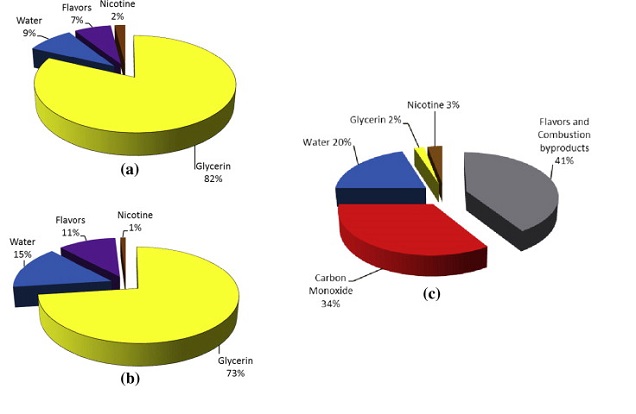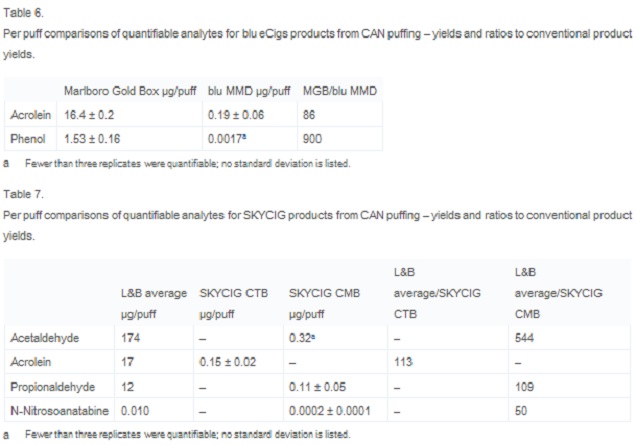
With all of the recent negative findings about e-cigarettes – from formaldegeddon to immune system impairment – a study simply re-confirming that e-cig vapor contains vastly fewer harmful components than cigarettes is, in a way, a nice reminder of the bigger picture. Of course, it’s nothing we don’t already know (and was actually published in back in December, in the journal Regulatory Toxicology and Pharmacology), but it underlines the core point that e-cigarette have the potential to save millions of lives around the world. According to the study’s findings, switching means reducing your exposure to toxic chemicals by a factor of about (probably over) 1,500. But there is a problem. This study comes from Lorillard – the tobacco giant that owns Blu and UK-based SkyCig. This isn’t a reason to discount it entirely (at least not before finding out the details), but for most vapers, this may stink more of a PR effort on behalf of cig-a-likes than a genuine attempt to add to the sum total of knowledge on the issue.
What They Did – Measuring Toxic Components in Smoke and Vapor
The design of the study (which you can read for free) was pretty straightforward: use a smoking machine to generate vapor from e-cigarettes and smoke from cigarettes and then analyze the results. Specifically, they were looking at quantities of nicotine, PG, VG, water, and toxic components including carbonyls (like formaldehyde and acrolein), tobacco-specific nitrosamines, metals, volatile organics (like benzene and toluene), polycyclic aromatic hydrocarbons and others.
The products used where solely SkyCig and Blu devices – two disposables (with 24 mg of nicotine), and three rechargeable ones (with 16 to 18 mg per cartridge). This represents a clear self-interest: aiming to show their own products to be low in harmful chemicals while missing the opportunity to really help anybody but themselves by also testing a higher-end device (at a reasonable setting, ideally). The basic e-liquids are the same, so the results still loosely apply, but the issue is that higher temperatures involved in high-power vaping increases the production of the chemicals that everybody is worried about. Additionally, no useful information was provided with regards to resistance or voltage, but anybody who’s used Blu before can testify that the power involved is low. So, if hypothetically you were conducting a science-ized PR stunt, this would be a pretty good way to go.
They also tested three types of cigarette – Marlboro Gold and Lambert and Butler original and menthol. Funnily enough, Lorillard doesn’t make these. It’s a cynically understandable decision to choose somebody else’s cigarettes, but it’s not like you can pretend that your cigarettes magically don’t release the butt-loads of harmful chemicals you get from combusted tobacco.
What They Found – E-Cigarettes Produce Much Fewer Dangerous Chemicals than Cigs

C) Cigarette smoke composition
The basic finding is the core reason most people vape: you’re exposing yourself to drastically fewer harmful components than you would be as a smoker. The simplest measurements are presented very broadly, separating both the composition of the e-liquid and the resulting aerosol (which we incorrectly call vapor) into VG, PG, water, nicotine and “flavorings.” It’s worth noting, though, that “flavorings” in this context literally translates to “anything else,” and includes the harmful and potentially harmful constituents discussed later on.
Non-the-less, the composition was relatively similar before and after vaporization, with the only differences being a decrease in nicotine, an increase in water and an increase in “flavorings” after vaporization. In contrast, cigarettes contain primarily carbon monoxide, combustion products and flavorings, and give off more nicotine than e-cigs (and more water too, surprisingly). According to their findings, cigarettes produce about 85 percent more nicotine than e-cigs overall: with the cigarettes delivering around 1.8 percent of their original nicotine content compared to about 0.2 percent for the most efficient e-cig tested (a SkyCig menthol).
It’s worth noting that despite the PR nature of the study, they found their own nicotine content to be quite off. The disposables claimed to be 24 mg, but were more like 20 to 21 mg, and the rechargables were between 11 and 13 mg, despite claiming to be 16 to 18 mg. I don’t personally mind about stringent accuracy in nicotine content (I know when I’ve had enough: mild nausea = probably time to stop vaping…), but it’s funny that they revealed their own incompetence.
The results for the harmful and potentially harmful chemicals (you know, the “flavorings”) are displayed as per puff values, based on measurements after 99 puffs, which were repeated three to five times for each e-cig. They can be explained simply too: almost everything either went undetected in e-cigs or it was at levels too low to quantify – basically too low to reliably distinguish from the background “noise.”
In any case, it’s clear that cigarettes contain a lot of harmful chemicals, for example, about 230 μg (0.230 mg) of carbonyls (formaldehyde and similar stuff) per puff, compared to less than 0.9 μg for any e-cig tested. Even in the first formaldehyde panic the formaldehyde content at the un-vape-ably high wattage per puff was (at the highest) 1.8 μg, whereas in the additional tables you can see that a Marlboro gold lets out around 7 μg per puff and for the Lambert and Butlers it’s around 10 μg per puff.
For the specific e-cigs where they detected something that couldn’t also be detected in the air (the smoking machine also puffed the room air to get baseline measurements), the comparative amounts are quite dramatic. There was 86 times less acrolein in a puff of Blu vapor than a puff of Marlboro smoke, and 900 times less phenol. For Lambert and Butler and SkyCig, there was over 540 times less acetaldehyde, over 110 times less acrolein and 50 times less of the one nitrosamine they detected in e-cig vapor.

So the totals of bad stuff, per puff, were less than 2 μg per puff for e-cigarettes and around 3000 μg per puff (3 mg) for the cigarettes. According to this, e-cigarettes have about 1,500 times less harmful or potentially harmful chemicals than cigarettes. However, they do note that “Though products tested, collection parameters, and analytical methods are not in common between this study and others, the results are very consistent.” While I’m not sure how or why the collection parameters and analytical methods are different (and this may be very relevant to the interpretation of the findings), the results are broadly in agreement with what we know.
However, it all comes back to the choice to focus on their crappy products: we know e-cigarettes have lower quantities of harmful components than cigarettes in any case, and we know that low power and no PG (as in Blu’s liquids) will lead to the lowest quantities. So that’s the only thing that really shoots this in the foot. But even the super-scary, unrealistic high voltage results from other studies are still considerably lower than those seen from the cigarettes in this one.
Conclusion – A Pinch of Salt with that, Please
So for Lorillard, this is ideal: show that our cig-a-likes are all cuddly and safe and let everyone go on making a big deal about high-power ones. But really, unless there’s some crippling methodology issue I’m missing, the findings are still the sort of thing we need to remind people of. For most actual users we should imagine we’ll be exposed to more than was observed here because we have better taste in devices (so 1,500 times less is a stretch, to say the least), but this study did provide the crucial comparison with cigarettes. Whenever a study makes a fair comparison between e-cigarettes and cigarettes, under normal (actually useable) conditions, the results are always the same: of course e-cigarettes are safer than cigarettes! And that should be all that matters.

